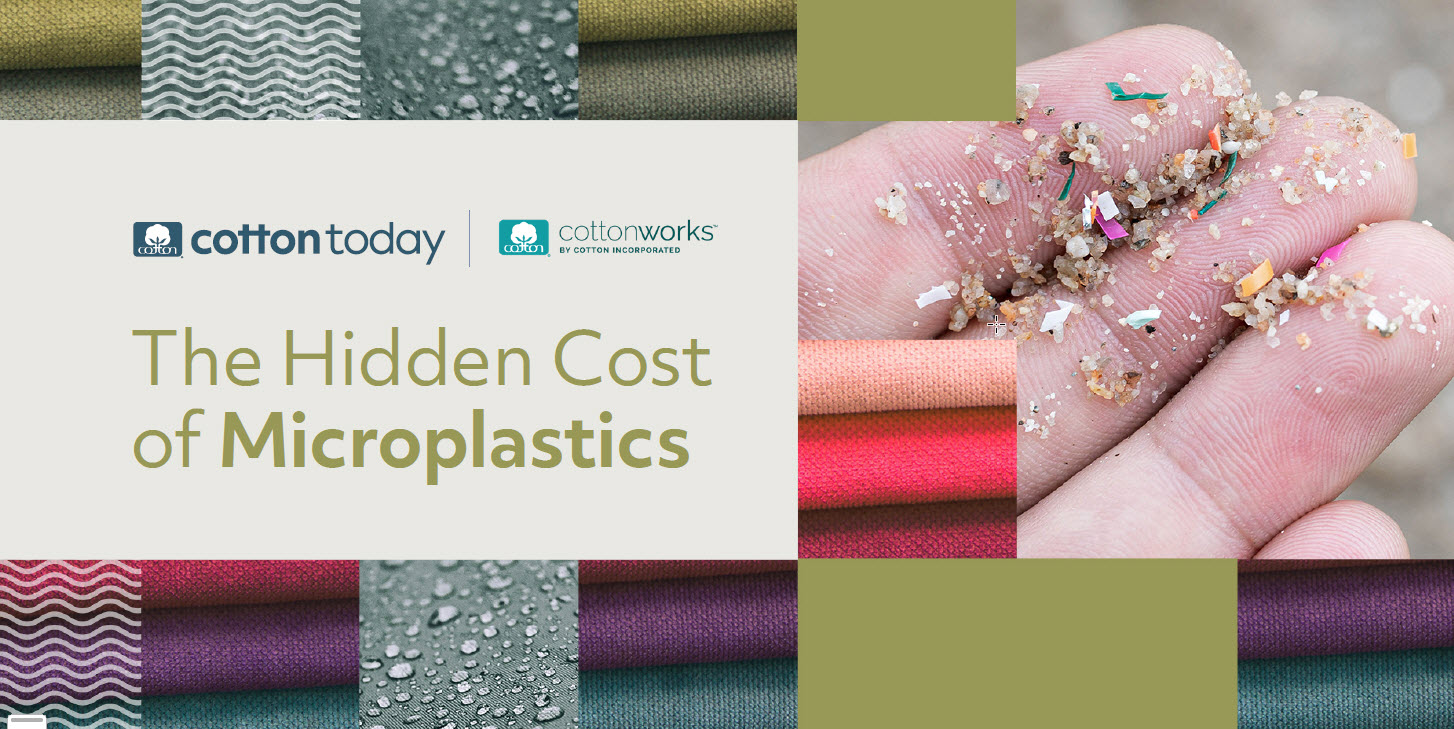Cotton: The Natural Choice for a Sustainable Future
In an era of growing environmental concern, cotton stands out as a naturally sustainable fiber, offering an alternative solution to the pervasive issue of microplastic pollution. Composed almost entirely of cellulose, cotton is a renewable resource that can readily biodegrade, seamlessly reintegrating into Earth’s natural carbon cycle.1
Textiles, both natural and synthetic, release tiny strands called microfibers during use and laundering. However, the critical difference lies in their environmental fate. While natural fibers like cotton are part of Earth’s natural cycle and decompose, synthetic fibers release microplastics—tiny plastic particles that persist in the environment.2, 3
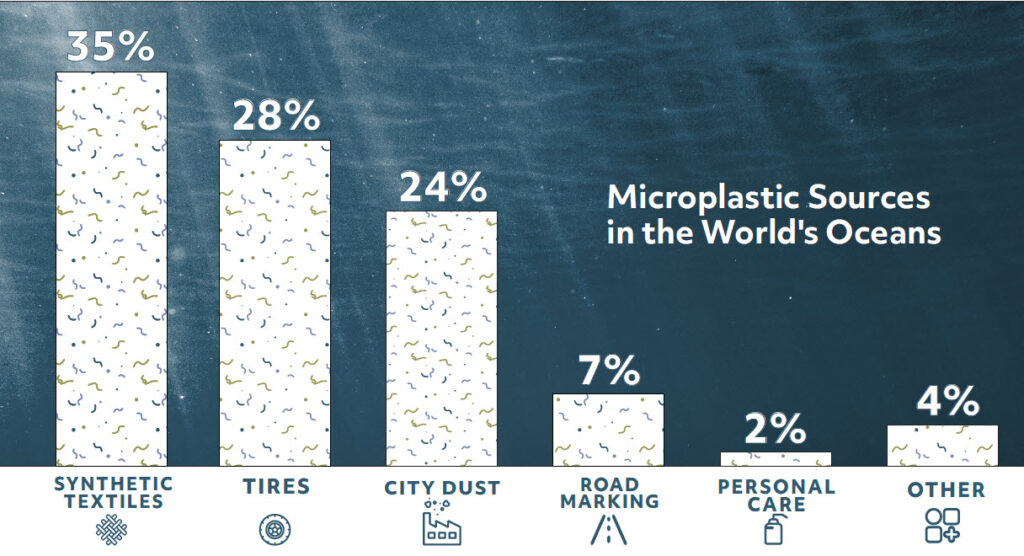
Figure 1. International Union for Conservation of Nature (IUCN). (2017). Primary microplastics in the oceans: A global evaluation of sources (IUCN Issues Brief No. 2017-002). Gland, Switzerland: IUCN. Retrieved from https://portals.iucn.org/library/node/46622
Cotton’s Natural Decomposition: Why It Matters
Natural fibers, like cotton and tree fibers used in paper making, are primarily composed of cellulose—the most abundant plant-based compound on Earth and a fundamental component of plant cell walls.4,5
Cotton is composed of approximately 95% cellulose.6 In fact, Earth naturally decomposes 1.5 trillion tons of cellulose every year.5
Unlike synthetic materials, cotton does not shed microplastics. Research shows that cotton fibers break down quickly—even when treated with common textile finishes—at rates similar to other natural materials like oak leaves.7
Life Cycle of Fiber Source
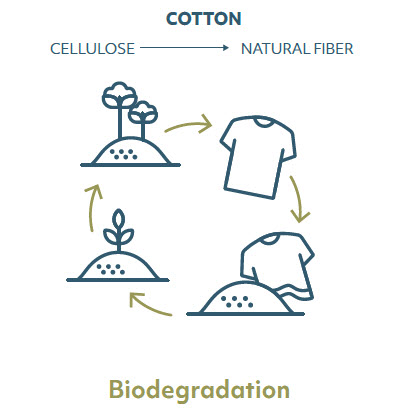
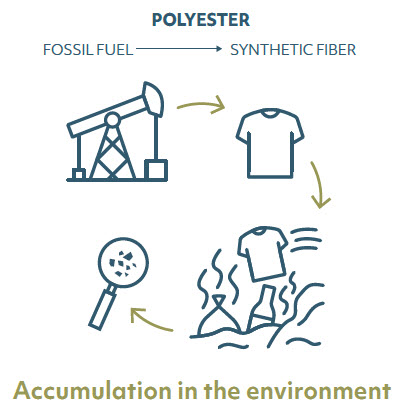
Microfibers: Cotton and Polyester

* Synthetic textiles such as polyester, which is made from polyethylene terephthalate (PET), are significantly less biodegradable than cellulose-based materials like cotton. This causes them to persist in environments like water and soil for long periods. For example, one month-long study found that polyester exhibited no appreciable biodegradation in freshwater and approximately 4% in seawater. Under the same conditions, cotton biodegraded by 77% in freshwater and 49% in seawater.9 Similarly, composting studies have shown that cotton fabrics degrade substantially in both laboratory and industrial settings, whereas polyester shows little to no biodegradation over comparable timeframes.1
** The manufacturing of synthetic fibers like polyester and nylon – which are petroleum-based plastics- can involve various chemical inputs. These include substances like BPA (bisphenol A), PAHs (polycyclic aromatic hydrocarbons), and heavy metals, which pose risks to both human health and the environment.10
The Persistent Problem of Microplastics
Synthetic microfibers persist in the environment due to their inability to biodegrade.9 After being released, microplastics can travel through wastewater systems, bypassing filtration and ultimately reaching rivers, lakes, and oceans.11 These tiny particles have also been detected in indoor and outdoor air, soil, and even in food and drinking water. One U.S. study published in 2025 also found that microplastic concentrations
in brain tissue samples from 2024 were approximately 50% higher than those measured in 2016 (n=20- 28).12 More studies are needed to understand whether microplastics and nanoplastics have a role in neurological disorders or other human health effects.
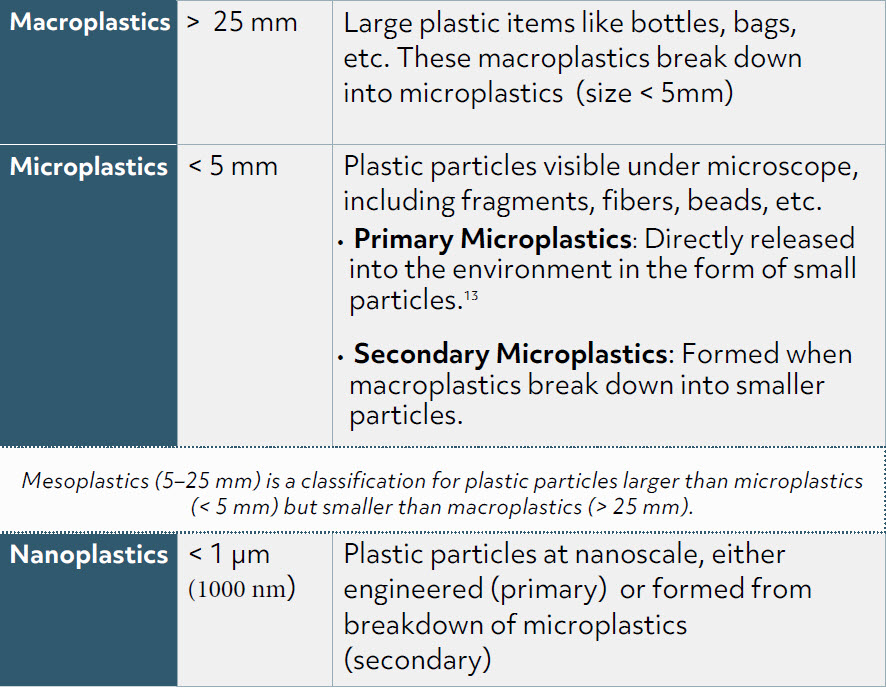
Table 1 GESAMP (2019). Guidelines or the monitoring and assessment of plastic litter and microplastics in the ocean (Kershaw P.J., Turra A. and Galgani F. editors), (IMO/FAO/UNESCO-IOC/UNIDO/WMO/IAEA/UN/UNEP/UNDP/ISA Joint Group of Experts on the Scientific Aspects of Marine Environmental Protection). Rep. Stud. GESAMP No. 99, 130p. Retrieved from http://www.gesamp.org/publications/guidelines-for-the-monitoring-and-assessment-of-plastic-litter-in-the-ocean
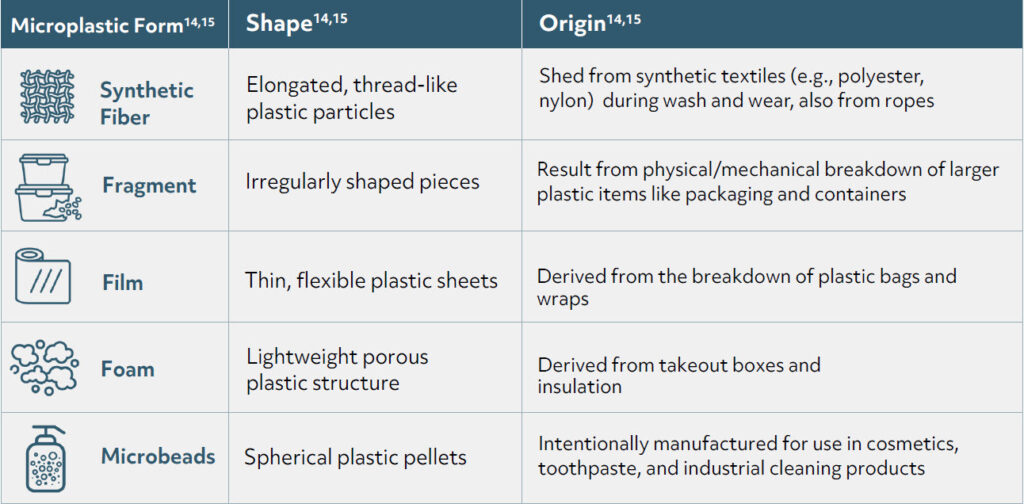
As a result of their persistence, synthetic microfibers may accumulate in the environment and potentially interact with other substances. Some studies suggest that synthetic microfibers can carry trace chemicals used in textile manufacturing, such as plasticizers and flame retardants.10 Additionally, synthetic microfibers contain inherently toxic compounds that are added to the plastics during the manufacturing process.10
How do Microplastics appear in the environment?
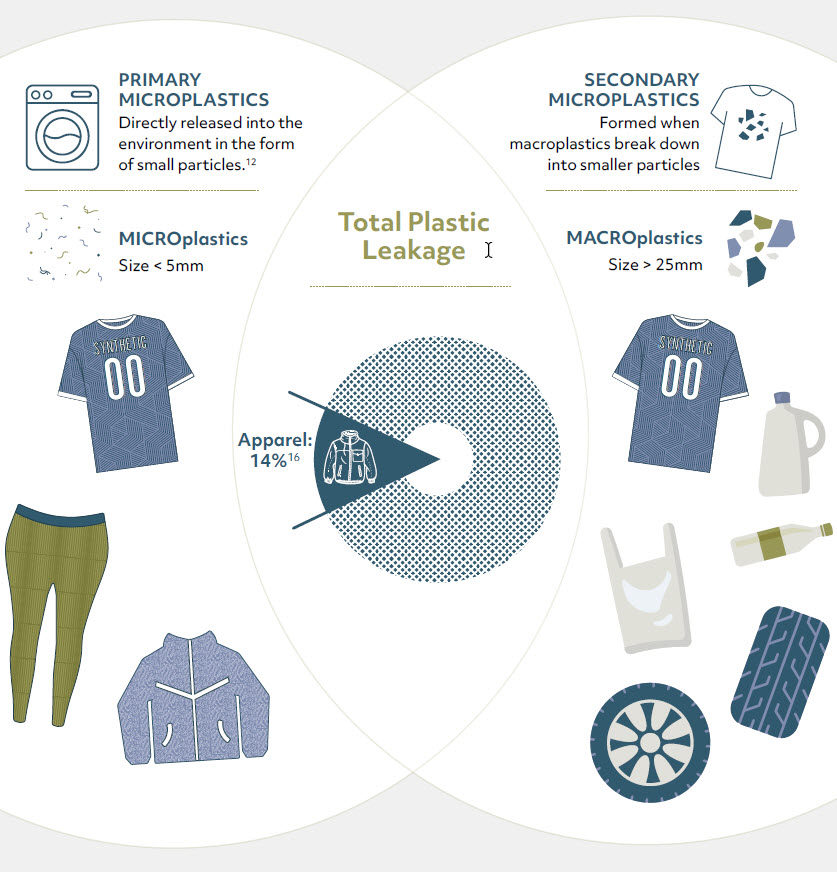
Figure 4 Kounina, A., Daystar, J., Chalumeau, S., Devine, J., Geyer, R., Pires, S. T., Sonar, S. U., Venditti, R. A., & Boucher, J. (2024). The global apparel industry is a significant yet overlooked source of plastic leakage. Nature Communications, 15, Article 3
What Impact Could Microplastics Have on Human Health?
Microplastics can enter living organisms and have been identified in various human tissues, including the lungs, placenta, blood, and brain, raising important questions about their potential health impacts.11,17
Current evidence points to possible associations between microplastic exposure and certain biological responses, such as inflammation, hormone disruption, and cardiovascular risks.11However, the full extent of any health effects remains an active area of scientific investigation. The following studies may not be generalizable due to study size and other limitations.

Human Brain Tissue
A 2025 study of deceased
individuals in the United States found microplastics and nanoplastics (MNPs) in human brain tissue.17 The research revealed a 50% increase in microplastics and nanoplastics concentration between 2016 and 2024, based on an analysis of 28 decedents from 2016 and 24 from 2024.17
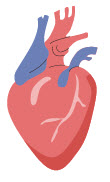
The cardiovascular system
Recent studies in China and Italy have documented microplastics and nanoplastics in the human cardiovascular system.18, 19 The 2024 study in China analyzed 17 arterial samples (coronary, carotid, and aortic) and detected microplastics and nanoplastics in every sample, with polyethylene terephthalate accounting for 74% of all plastics identified.18 The 2024 study in Italy followed 257 carotid surgery patients for 34 months and found microplastics and nanoplastics (mainly polyethylene, some polyvinyl chloride) in the carotid plaques of 58% of patients.
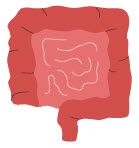
The digestive system
Microplastics have been detected in human stool samples, indicating ingestion through food and water.22 A 2021 pilot study in the U.S. found significantly higher levels of polyethylene terephthalate in the feces of infants (n=6; median 36,000 ng/g) compared with adults (n=10; median 2,600 ng/g).22 Additionally, a 2024 pilot study in Austria detected microplastics in all 60 stool samples from 15 adults, linking higher levels to greater plastic use and processed food intake.23 Polyethylene, polypropylene, and polyethylene terephthalate were the most frequently detected polymers.23
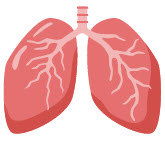
The respiratory system
We can breathe microplastic fibers from synthetic textiles.20 One study from 2022 in the UK detected microplastics in 11 of 13 lung tissue samples collected, with polypropylene and polyethylene terephthalate among the most common polymers.20 Similarly, a 2022 study in Spain identified microplastics in 30 of 44 bronchoalveolar lavage samples, noting that 97% of the particles were plastic microfibers.21
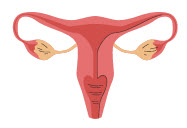
The reproductive system
Microplastics have also been detected in the human reproductive system, specifically in ovarian follicular fluid surrounding developing eggs.24,25 A 2025 study in Italy found microplastics in 14 of 18 ovarian follicular fluid samples from women undergoing fertility treatment, with an average of 2,191 particles per milliliter (range 0–7,181).24 Another 2025 study in China analyzed ovarian follicular fluid from 19 women (ages 25–40) undergoing In vitro fertilization (IVF) or Intracytoplasmic Sperm Injection (ICSI) in 2024 and identified 1,739 microplastics across 30 polymer types, including polyethylene terephthalate.25
1 Li, Lili, M. F., & Browning, K. J. (2010). Biodegradability Study on Cotton and Polyester Fabrics, 5(4). Retrieved from https://journals.sagepub.com/doi/abs/10.1177/155892501000500406.
2 Marielis C. Zambrano et al. (2020). Aerobic Biodegradation in Freshwater and Marine Environments of Textile Microfibers Generated in Clothes Laundering: Effects of Cellulose and Polyester-Based Microfibers on the Microbiome. Marine Pollution Bulletin 151: p. 110826, https://doi.org/10.1016/j.marpolbul.2019.110826.
3 Marielis C. Zambrano et al. (2019). Microfibers Generated from the Laundering of Cotton, Rayon and Polyester Based Fabrics and Their Aquatic Biodegradation. Marine Pollution Bulletin 142: pp. 394-407, https://doi.org/10.1016/j.marpolbul.2019.02.062.
4 Ho, N. W. Y., Ladisch, M. R., Sedlak, M., Mosier, N., & Casey, E. (2011). Biofuels from Cellulosic Feedstocks. Comprehensive Biotechnology, Second Edition, 3, 51–62. https://doi.org/10.1016/B978-0-08-088504-9.00155-0
5 Thomas Heinze (2015). Cellulose: Structure and Properties. Cellulose Chemistry and Properties: Fibers, Nanocelluloses and Advanced Materials. pp 1-52. https://link.springer.com/chapter/10.1007/12_2015_319
6 Wakelyn, P.J. (2006). Cotton Fiber Chemistry and Technology (1st ed.). CRC Press. Chapter 3.
7 Marielis C. Zambrano et al. (2021). Impact of Dyes and Finishes on the Aquatic Biodegradability of Cotton Textile Fibers and Microfibers Released on Laundering Clothes: Correlations between Enzyme Adsorption and Activity and Biodegradation Rates. Marine Pollution Bulletin 165: p. 112030. https://doi.org/10.1016/j.marpolbul.2021.112030.
8 Hubbe, M. A., et al. (2025). Biodegradability of Cellulose Fibers, Films, and Particles: A Review. BioResources, 20(1), 2391–2458.
9 Marielis C. Zambrano et al. (2020). Aerobic Biodegradation in Freshwater and Marine Environments of Textile Microfibers Generated in Clothes Laundering: Effects of Cellulose and Polyester-Based Microfibers on the Microbiome. Marine Pollution Bulletin 151: p. 110826, https://doi.org/10.1016/j.marpolbul.2019.110826.
10 Wiesinger, H., Shalin, A., Huang, X., Siegrist, A., Plinke, N., Hellweg, S., & Wang, Z. (2024). LitChemPlast: An open database of chemicals measured in plastics. Environmental Science & Technology Letters, 11(11). https://pubs.acs.org/doi/10.1021/acs.estlett.4c00355
11 U.S. Environmental Protection Agency. (2020). What You Should Know About Microfiber Pollution. https://www.epa.gov/sites/default/files/2020-08/documents/article_2_microfibers_formatted.pdf
12 Nihart AJ et al.(2025). Bioaccumulation of microplastics in decedent human brains. Nature Medicine. DOI:10.1038/s41591-024-03453-1d
13 Boucher, J., Friot, D. (2017). Primary Microplastics in the Oceans: a Global Evaluation of Sources. International Union for Conservation of Nature. https://portals.iucn.org/library/sites/library/files/documents/2017-002-En.pdf
14 GESAMP (2019). Guidelines or the monitoring and assessment of plastic litter and microplastics in the ocean (Kershaw P.J., Turra A. and Galgani F. editors), (IMO/FAO/UNESCO-IOC/ UNIDO/WMO/IAEA/UN/UNEP/UNDP/ISA Joint Group of Experts on the Scientific Aspects of Marine Environmental Protection). Rep. Stud. GESAMP No. 99, 130p. Link
15 Hartmann, B.N., et al. (2019). Are We Speaking the Same Language? Recommendations for a Definition and Categorization Framework for Plastic Debris. Environmental Science & Technology 2019 53 (3), 1039-1047. DOI: 10.1021/acs.est.8b05297
16 Kounina, A., Daystar, J., Chalumeau, S., Devine, J., Geyer, R., Pires, S. T., Sonar, S. U., Venditti, R. A., & Boucher, J. (2024). The global apparel industry is a significant yet overlooked source of plastic leakage. Nature Communications, 15, Article 3701. https://doi.org/10.1038/s41467-024-49441-4
17 Nihart, A.J., Garcia, M.A., El Hayek, E. et al. Bioaccumulation of microplastics in decedent human brains. Nat Med 31, 1114–1119 (2025). https://doi.org/10.1038/s41591-024-03453-1
18 Liu S, Wang C, Yang Y, Du Z, Li L, Zhang M, Ni S, Yue Z, Yang K, Wang Y, Li X, Yang Y, Qin Y, Li J, Yang Y, Zhang M. (2024). Microplastics in three types of human arteries detected by pyrolysis-gas chromatography/mass spectrometry (Py-GC/MS). Journal of Hazardous Materials. DOI: 10.1016/j.jhazmat.2024.133855
19 Marfella, R., Prattichizzo, F., Sardu, C., Fulgenzi, G., Graciotti, L., Spadoni, T., D’Onofrio, N., & Paolisso, G. (2024). Microplastics and nanoplastics in atheromas and cardiovascular events. New England Journal of Medicine, 390(10), 900–910. https://doi.org/10.1056/NEJMoa2309822
20 Jenner, L., Rotchell, J., Bennett, R., Cowen, M., Tentzeris, V., Sadofsky, L. (2022). Detection of microplastics in human lung tissue using μFTIR spectroscopy. ScienceDirect. https://doi.org/10.1016/j.scitotenv.2022.154907
21 Baeza-Martínez, C., Olmos, S., González-Pleiter, M., López-Castellanos, J., García-Pachón, E., Masiá-Canuto, M., Hernández-Blasco, L., Bayo, J. (2022). First evidence of microplastics isolated in European citizens’ lower airway. ScienceDirect. https://doi.org/10.1016/j.jhazmat.2022.129439
22 Zhang, J., Wang, L., Trasande, L., Kannan, K. (2021). Occurrence of Polyethylene Terephthalate and Polycarbonate Microplastics in Infant and Adult Feces. Environmental Science & Technology Letters. DOI: 10.1021/acs.estlett.1c00559
23 Hartmann, C., Lomako, I., Schachner, C., El Said, E., Abert, J., Satrapa, V., Kaiser, A., Walch, H., Köppel, S. (2024). Assessment of microplastics in human stool: A pilot study investigating the potential impact of diet-associated scenarios on oral microplastics exposure. ScienceDirect. https://doi.org/10.1016/j.scitotenv.2024.175825
24 Montano, L., Raimondo, S., Piscopo, M., Ricciardi, M., Guglielmino, A., Chamayou, S., Gentile, R., Gentile, M., Rapisarda, P., Oliveri Conti, G., Ferrante, M., & Motta, O. (2025). First evidence of microplastics in human ovarian follicular fluid: An emerging threat to female fertility. Ecotoxicology and Environmental Safety, 291, 117868. https://doi.org/10.1016/j.ecoenv.2025.117868
25 Ni, D., Yu, K., Yan, N., Chen, X., Xie, Q., Yang, Y., Jiang, W., Yang, Y., Zhang, J., Ling, X. (2025). Characterization of microplastics in human follicular fluid and assessment of their potential impact on mouse oocyte maturation in vitro. ScienceDirect. https://doi.org/10.1016/j.ecoenv.2025.117796
